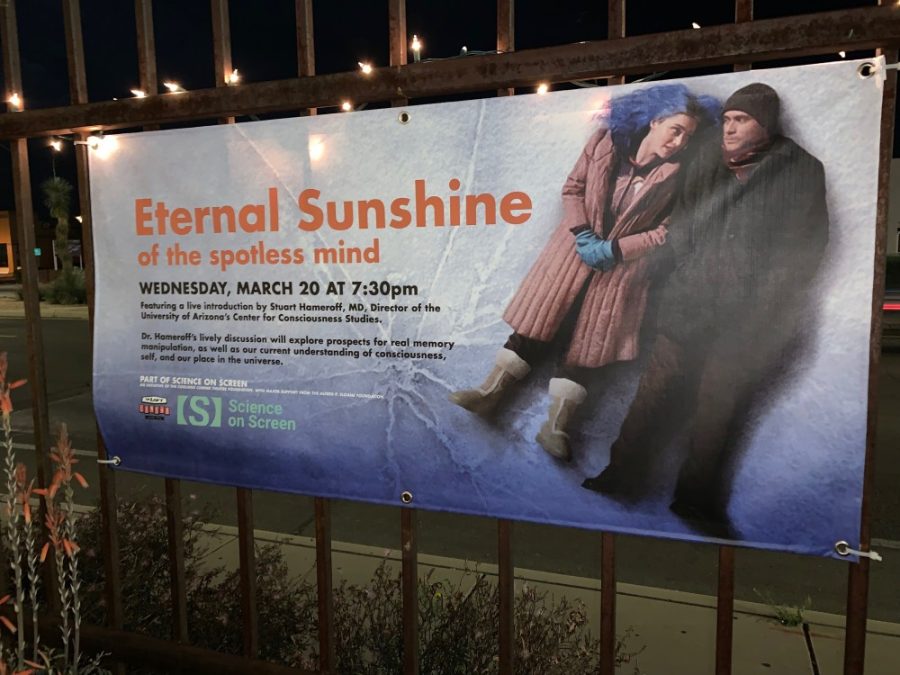The Loft Cinema presented “Eternal Sunshine of the Spotless Mind” Wednesday night as part of the Science On Screen program. Dr. Stuart Hameroff, director of the University of Arizona’s Center for Consciousness Studies, spoke to the audience before the film on scientific possibilities of memory manipulation.
Hameroff’s presentation, titled “Eternal Sunshine … with a chance of showers,” talked about traumatic memories in the brain and how science has worked towards being able to erase those memories.
“Getting rid of them, erasing traumatic memory, is a worthy goal in medicine and neuroscience,” Hameroff said.
He explained what scientists know about memory and how and where it is all stored in the brain. This discussion connected to the film, as the 2004 Oscar-winning movie, directed by Michel Gondry, focuses on two former lovers, played by Jim Carrey and Kate Winslet, who use an experimental procedure to erase their memories of each other.
RELATED: Loft panel examines mental illness on screen and in life
The Science On Screen program is an initiative of the Coolidge Corner Theater in Brookeline, Mass., in partnership with the Alfred P. Sloan Foundation. These sponsors provide the grant funding for The Loft to put on the series. The program began in 2005 and pairs films with experts in the fields of science and technology.
Select independent theaters across the country take part in the program. This is the sixth year The Loft has presented Science On Screen.
“The recurring idea is to use one of America’s favorite pastimes, which is going to the movies, to get people stoked about science. And you should be because science is very important,” said Jeff Yanc, program director at The Loft.
Yanc opened up the pre-film discussion and introduced Hameroff, telling the audience he loves the series and has learned a lot from seeing the films and hearing the discussions each year. He said the series at The Loft has encompassed everything from an outdoor screening of The Martian at Biosphere 2 to a screening of “Night of the Living Dead,” which featured a presentation by a Harvard University brain surgeon.
“It’s all a learning experience for us,” Yanc said. “It’s been very interesting, and tonight will be no exception to that.”
Hameroff’s discussion and slideshow presentation talked about reconsolidation, where long-term memory moves into consciousness and then moves back into memory. This phase is the easiest time for memory to be altered, according to Hameroff.
Hameroff also said the strength of the memory, how long we will remember it, how much of it we will remember and how much it will impact us are due to its emotional content.
“That is imparted by a little structure called the amygdala,” Hameroff said. “The amygdala processes fear and emotion, and if something happens to us, and it’s a strong, emotional impact, we’re going to remember it more strongly. It could be good, it could be bad.”
RELATED: Creating a horror movie “Slumber Party”
Hameroff told the audience about four ways of erasing memories that are “possible, or have been tried, or are being tried even as we speak.” Those four are to detach emotional reactions from the traumatic memory with drugs, to re-associate the traumatic memory with pleasure, to disrupt the specific brain structures that encode traumatic memory and therapy or brain stimulation.
“I don’t think the brain works as a computer, I think it’s more like an orchestra,” Hameroff said. “Consciousness is more like music than it is a computation.”
The presentation was followed with questions for Hameroff asked by the audience and the showing of “Eternal Sunshine of the Spotless Mind.”
“I love this movie, it’s a kick every time I see it,” Hameroff said at the end.
Follow Quincy Sinek on Twitter









